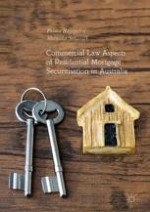2019 | OriginalPaper | Chapter
4. Mortgage Origination
Authors : Pelma Rajapakse, Shanuka Senarath
Published in: Commercial Law Aspects of Residential Mortgage Securitisation in Australia
Publisher: Springer International Publishing
Activate our intelligent search to find suitable subject content or patents.
Select sections of text to find matching patents with Artificial Intelligence. powered by
Select sections of text to find additional relevant content using AI-assisted search. powered by
